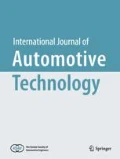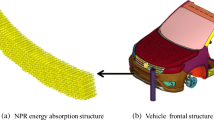Abstract
Lower limb injuries occur frequently in vehicle-to-pedestrian collisions and vehicle front-end shape has a significant influence on pedestrian lower limb injuries Therefore, the aim of the current study is to propose an effective optimization framework for vehicle front-end design and to predict safer vehicle front-end shapes for pedestrian lower limb protection using this optimization framework. To achieve this, an optimization framework combining the genetic algorithm (GA) in MATLAB and finite element (FE) simulations in LS-DYNA was proposed and applied to predict safer vehicle frontend shapes for pedestrian lower limb protection. The optimization results indicate that it is feasible and reliable to use the proposed optimization framework in vehicle front-end shape optimization for pedestrian lower limb protection. The predicted safer vehicle front-end shapes suggest that the vehicle front-end designs with a lower bumper stiffener close to the ankle, a bumper absorber higher than the knee and a bonnet leading edge above the hip joint would be beneficial for pedestrian lower limb protection. Biomechanical analysis implies that a plane-approximating support to both the upper and lower leg from the vehicle front-end structure could reduce lower limb lateral bending and hence injury risk greatly.
Similar content being viewed by others
Abbreviations
- LBSH:
-
lower bumper stiffener height, mm
- LBSD:
-
lower bumper stiffener depth, mm
- BAH:
-
bumper absorber height, mm
- BLEH:
-
bonnet leading edge height, mm
- BLED:
-
bonnet leading edge depth, mm
References
Arnoux, P. J., Cavallero, C., Chabrand, P. and Brunet, C. (2002). Knee ligament failure under dynamic loadings. Int. J. Crashworthiness7, 3, 255–268.
Cai, Z., Lan, F. and Chen, J. (2015). Development and validation of a human biomechanical model for rib fracture and thorax injuries in blunt impact. Computer Methods in Biomechanics and Biomedical Engineering18, 9, 974–980.
Cao, L., Du, X., Zhang, G., Hu, Y. and Zhang, K. (2015). Development and validation of the 50th percentile Chinese male lower leg FE model. Automotive Engineering37, 11, 1291–1297.
C-NCAP (2018). China New Car Assessment Programme Management Regulation (2018 Edition). China Automotive Technology and Research Center.
Euro-NCAP (2017). Pedestrian Testing Protocol, Version 8.4. European New Car Assessment Programme.
Guan, T. (2019). Modeling and Application of a China 50 Percentile Pedestrian Lower Limb Finite Element Model. M. S. Thesis. Hunan University. Hunan, China.
Isshiki, T., Konosu, A. and Takahashi, Y. (2015). Analysis of the causes of differences in impact responses between a human lower limb and the flexible pedestrian legform impactor under low and high bumper vehicle impact situations. Proc. Int. Research Council on Biomechanics of Injury (IRCOBI) Conf., Lyons, France.
Kerrigan, J., Drinkwater, D., Kam, C., Murphy, D. B., Ivarsson, B., Crandall, J. and Patrie, J. (2004). Tolerance of the human leg and thigh in dynamic latero-medial bending. Int. J. Crashworthiness9, 6, 607–623.
Li, G., Lyons, M., Wang, B., Yang, J., Otte, D. and Simms, C. (2017a). The influence of passenger car front shape on pedestrian injury risk observed from German in-depth accident data. Accident Analysis & Prevention, 101, 11–21.
Li, G., Otte, D., Yang, J. and Simms, C. (2016). Pedestrian injury trends evaluated by comparison of the PCDS and GIDAS databases. Proc. Int. Research Council on Biomechanics of Injury (IRCOBI) Conf., Seoul, Korea.
Li, G., Yang, J. and Simms, C. (2015). The influence of gait stance on pedestrian lower limb injury risk. Accident Analysis & Prevention, 85, 83–92.
Li, G., Yang, J. and Simms, C. (2017b). Safer passenger car front shapes for pedestrians: A computational approach to reduce overall pedestrian injury risk in realistic impact scenarios. Accident Analysis & Prevention, 100, 97–110.
Li, G., Wang, F., Otte, D., Cai, Z. and Simms, C. (2018). Have pedestrian subsystem tests improved passenger car front shape?. Accident Analysis & Prevention, 115, 143–150.
Li, G., Tan, Z., Lv, X. and Ren, L. (2019). A computationally efficient finite element pedestrian model for head safety: Development and validation. Applied Bionics and Biomechanics, 2019, Article ID 4930803, 1–13.
Liu, X., Yang, J. and Lovsund, P. (2002). A study of influences of vehicle speed and front structure on pedestrian impact responses using mathematical models. Traffic Injury Prevention3, 1, 31–42.
LSTC (2007). LS-DYNA Keyword User’s Manual Version 971. Livermore Software Technology Corporation.
Nie, B. and Zhou, Q. (2016). Can new passenger cars reduce pedestrian lower extremity injury: A review of geometrical changes of front-end design before and after regulatory efforts. Traffic Injury Prevention17, 7, 712–719.
Mathworks (2019). Global Optimization Toolbox, MATLAB R2018b. https://www.mathworks.com/products/global-optimization.html
Matsui, Y. (2005). Effects of vehicle bumper height and impact velocity on type of lower extremity injury in vehicle-pedestrian accidents. Accident Analysis & Prevention37, 4, 633–640.
Matsui, Y., Ishikawa, H. and Sasaki, A. (1999). Pedestrian injuries induced by the bonnet leading edge in current car-pedestrian accidents. SAE Paper No. 1999-01-0713.
Mizuno, Y. (2005). Summary of IHRA pedestrian safety working group activities — Proposed test methods to evaluate pedestrian protection offered by passenger cars. Proc. 19th Experimental Safety Vehicles Conf., Washington, USA.
Mo, F., Arnoux, P. J., Avalle, M., Scattina, A., Semino, E. and Masson, C. (2015). Incidences of various passenger vehicle front-end designs on pedestrian lower limb injuries. Int. J. Crashworthiness20, 4, 337–347.
Mo, F., Li, F., Behr, M., Xiao, Z., Zhang, G. and Du, X. (2018). A lower limb-pelvis finite element model with 3D active muscles. Annals of Biomedical Engineering46, 1, 86–96.
Mo, F., Li, J., Dan, M., Liu, T. and Behr, M. (2019). Implementation of controlling strategy in a biomechanical lower limb model with active muscles for coupling multibody dynamics and finite element analysis. J. Biomechanics, 91, 51–60.
Otte, D. and Haasper, C. (2007). Characteristics on fractures of tibia and fibula in car impacts to pedestrians and bicyclists-influences of car bumper height and shape. Annual Proc. Association for the Advancement of Automotive Medicine, 51, 63–79.
Petit, P., Trosseille, X., Dufaure, N., Dubois, D., Potier, P. and Vallancien, G. (2014). The effect of upper body mass and initial knee flexion on the injury outcome of post mortem human subject pedestrian isolated legs. Stapp Car Crash J., 58, 197–211.
Scattina, A., Mo, F., Masson, C., Avalle, M. and Arnoux, P. J. (2018). Analysis of the influence of passenger vehicles front-end design on pedestrian lower extremity injuries by means of the LLMS model. Traffic Injury Prevention19, 5, 535–541.
Simms, C. and Wood, D. (2009). Pedestrian and Cyclist Impact. Springer. Berlin, Germany.
Untaroiu, C., Shin, J., Crandall, J., Fredriksson, R., Bostrom, O. and Takahashi, Y. (2010). Development and validation of pedestrian sedan bucks using finite-element simulations: A numerical investigation of the influence of vehicle automatic braking on the kinematics of the pedestrian involved in vehicle collisions. Int. J. Crashworthiness15, 5, 491–503.
Wang, F., Yu, C., Li, G., Han, Y., Wang, B., Yang, J. and Lan, D. (2018). A study on influence of minivan frontend design and impact velocity on pedestrian thorax kinematics and injury risk. Applied Bionics and Biomechanics, 2018, Article ID 7350159, 1–8.
Wu, T., Kim, T., Bollapragada, V., Poulard, D., Chen, H., Panzer, M., Forman, J., Crandall, J. and Pipkorn, B. (2017). Evaluation of biofidelity of THUMS pedestrian model under a whole-body impact conditions with a generic sedan buck. Traffic Injury Prevention18, Supplement 1, S148–S154.
Acknowledgement
This work was supported by the National Natural Science Foundation of China (Grant No. 51805162), Natural Science Foundation of Hunan Province (Grant No. 2018JJ3532) and Scientific Research Fund of Hunan Provincial Education Department (Grant No. 17C0640).
Author information
Authors and Affiliations
Corresponding author
Additional information
Publisher’s Note
Springer Nature remains neutral with regard to jurisdictional claims in published maps and institutional affiliations.
Rights and permissions
About this article
Cite this article
Li, G., Ma, H., Guan, T. et al. Predicting Safer Vehicle Font-End Shapes for Pedestrian Lower Limb Protection via a Numerical Optimization Framework. Int.J Automot. Technol. 21, 749–756 (2020). https://doi.org/10.1007/s12239-020-0073-0
Received:
Revised:
Accepted:
Published:
Issue Date:
DOI: https://doi.org/10.1007/s12239-020-0073-0




